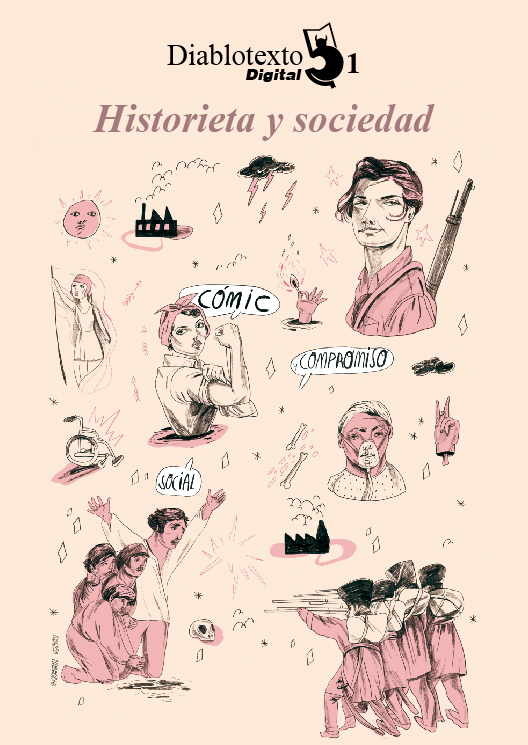Tono and his «tonerías» (1938). The artistic vanguard in the service of the rebel propaganda
DOI:
https://doi.org/10.7203/diablotexto.1.8855Keywords:
Spanish Civil War, nationalist rebels, caricature, propaganda, representation of the enemy Abstract
Abstract
Among the famous illustrators who provide an inconditional support to the rebel cause, there is Antonio de Lara, also known as Tono. He represented the Art-Deco movement in the 20s; over time his art becam simpler under cubist, surrealist, dadaist or constructivist influences. His style was from then on easily identifiable, mostly for the geometric drawing of his cartoon characters but also trough the absurd situations reminiscent of the English nonsense tradition, introduced in Spain by Ramón Gómez de la Serna. Tono, in France when the Civil War broke out, decided to cross the border in order to join the self-proclaimed “nationalists”, giving up his traditional apolisticism. He played an important part in emblematic magazines such as Vértice or La Ametralladora. In 1938, he published a book called 100 tonerias in which he collected one hundred cartoons. Most of them caricature the enemies with a number of characters who, like a comic, end up building an original universe with its own code and who are an efficient vehicle of propaganda.
 Downloads
Downloads
 References
References
Bonet, Juan Manuel (1995). Diccionario de las vanguardias en España (1907-1936). Madrid: Alianza Editorial.
Canal, Jordi (2008). “Matar negros, hacer blancos: los colores y los nombres del enemigo en las guerras civiles de la España contemporánea”, Espacio, Tiempo y Forma, Serie V, Historia Contemporánea, n.° 20, pp. 19-36.
Cervera, Javier [1998)] (2006). Madrid en guerra. La ciudad clandestina, 1936-1939. Madrid: Alianza Editorial.
Del Cura, María Isabel; Huertas, Rafael (2009). Alimentación y enfermedad en tiempos de hambre. España, 1937-1947. Madrid: CSIC.
Díaz Plaja, Fernando (1995). La vida cotidiana en la España de la guerra civil. Madrid: Edaf.
Fernández-Hoya, Gema. “Antonio de Lara Gavilán «Tono»: genio e ingenio en las artes plásticas”, Creneida, 2013, n.° 1, pp. 290-311.
Fortuño Llorens, Santiago (1998). “La poesía de la otra generación del 27 (Edgar Neville, Jardiel Poncela y López Rubio)”. En Burguera Nadal, María Luisa; Fortuño Llorens, Santiago (eds.) (2008) Vanguardia y humorismo: la otra generación del 27. Castelló de la Plana: Publicaciones de la Universidad Jaume I.
Gómez de la Serna, Ramón (1930). “Gravedad e importancia del humorismo”, Revista de Occidente, n.° 84, pp. 348-391.
Llera, José Antonio (2007). “Documentos inéditos sobre La Ametralladora y La Codorniz de Miguel Mihura”, Anales de Literatura Española, n.° 19, pp. 115-135.
López Rubio, José. La otra generación del 27. Discurso y cartas (2003). Madrid: Ministerio de Educación y Cultura.
Molins, Patricia (2002). Los humoristas del 27, Madrid: Ministerio de Educación, Cultura y Deporte / Sinsentido.
Molins, Patricia (2002). “Superhumorismo: Jardiel y Tono”. En Los humoristas del 27, op. cit., Sinsentido, pp. 81-92.
Miralles, Ricardo et al (2009). Los rusos en la Guerra de España. Madrid: Fundación Pablo Iglesias.
Moreiro, Julio (2004). Miguel Mihura. Humor y melancolía. Madrid: Algaba.
Moreiro, Julio (2007). “«María de la hoz». Tono y Mihura en las trincheras”, Anales de Literatura española, 19, pp. 161-172.
Moreno Cantano, Antonio César (2008). Los servicios de prensa extranjera en el primer franquismo (1936-1945), Universidad de Alcalá de Henares, tesis doctoral.
Núñez Seixas, Xosé Manoel (2006). ¡Fuera el invasor! Nacionalismos y movilización bélica durante la guerra civil española (1936-1939). Madrid: Marcial Pons.
Pastoureau, Michel (2000). Bleu. Histoire d’une couleur. Paris: Éditions du Seuil.
Pérez Rojas, Javier (1997), La Eva moderna. Ilustración gráfica española 1914-1935. Madrid: Fundación Cultural Mafpre.
Pulpillo Leiva, Carlos (2013). Orígenes del franquismo: la construcción de la “Nueva España” (1936–1941), Universidad Rey Juan Carlos, tesis doctoral.
Ríos Carratalá, Juan Antonio (2005). “La guerra de los humoristas”, Quimera, n.° 257, pp. 18-22.
Rodríguez Puértolas, Julio (1986). Historia de la Literatura fascista española. Madrid: Akal.
Saussure, Ferdinand (1968). Cours de linguistique générale. Wiesbaden: Harrassowitz.
Seco, Manuel et al. (1999). Diccionario del español actual. Madrid: Aguilar.
Seoane, María Cruz; Sáiz, María Dolores (1996). Historia del periodismo en España, 3. El siglo XX: 1898-1936. Madrid: Alianza Editorial.
Tillier, Bertrand (2005). À la charge ! La caricature en France de 1789 à 2000. Paris: Les Éditions de l’Amateur.
Tono (1938). 100 tonerías de Tono. San Sebastián: Nueva Editorial.
Tono (1960). ¡Viva yo! Historia larga de una vida corta. Barcelona: Bruguera, 1960.
Weis Bauer, Samuel Michael (2012). Cincuenta años de Humor Nuevo: la obra de Antonio de Lara Gavilán (1921-1971). Universitat Autònoma de Barcelona, tesis doctoral, en https://ddd.uab.cat/pub/tesis/2012/hdl_10803_96318/smwb1de1.pdf [20-04-2016].
Downloads
Published
How to Cite
-
Abstract951
-
PDF (Español)570
Issue
Section
License
Licencia de reconocimiento de Creative Commons “Reconocimiento - No Comercia l- Sin Obra Derivada
Authors who publish with this journal agree to the following items:
The authors will keep their copyright and guarantee the journal the right of first publication of their work, which will be simultaneously subject to the Creative Commons license that allows third parties to share the work indicating its author and its first publication in the journal. The authors may adopt other non-exclusive license agreements to distribute the version of the published work (e.g., depositing it in an institutional telematic file or publishing it in a monographic volume), with an acknowledgment of its initial publication in this journal. The authors are allowed and encouraged to disseminate their work through the Internet (e.g., in institutional telematic archives or on their website) before and during the submission process, which can produce interesting exchanges and increase citations of the published work. (See Effect of Open Access)




